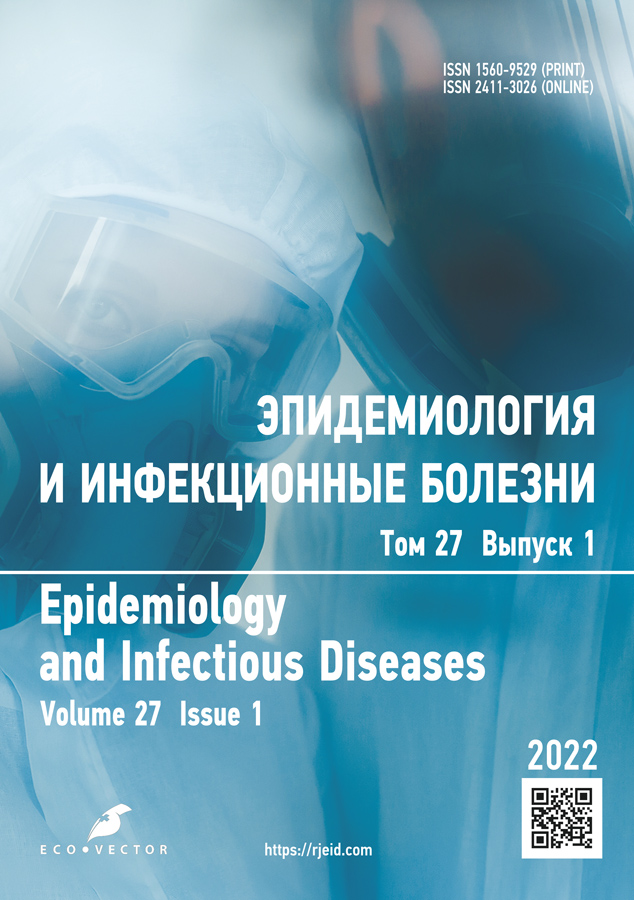On the readiness of medical organizations to prevent the introduction and spread of dangerous infectious diseases
- 作者: Nikiforov V.V.1,2, Suranova T.G.2, Mironov A.Y.2,3
-
隶属关系:
- The Russian National Research Medical University named after N.I. Pirogov
- Federal Research and Clinical Center of Specialized Medical Care and Medical Technologies
- G.N. Gabrichevsky Research Institute for Epidemiology and Microbiology
- 期: 卷 27, 编号 1 (2022)
- 页面: 60-70
- 栏目: Lectures
- ##submission.dateSubmitted##: 30.05.2022
- ##submission.dateAccepted##: 11.07.2022
- ##submission.datePublished##: 07.10.2022
- URL: https://rjeid.com/1560-9529/article/view/108391
- DOI: https://doi.org/10.17816/EID108391
- ID: 108391
如何引用文章
详细
The Ebola epidemic, the spread of HIV infection, the COVID-19 pandemic, climate warming, the activation of natural foci of dangerous infections, the destabilization of the situation in the world, and the threat of bioterrorism are the realities of today. Threats to biological safety are caused by the activation in the last decade of a number of biological risks, such as an increase in the probability of importation into the territory of the Russian Federation of rare or previously unknown infections, in particular polio caused by “wild” poliovirus, malaria, cholera, tuberculosis, and so forth; activation of natural foci of dangerous and especially dangerous infections; the spread of infections associated with the provision of medical care; the possibility of accidents or sabotage at facilities where work is carried out with pathogenic microorganisms, biological terrorism in all its manifestations.
Increasing the readiness of medical organizations to counter biological threats is one of the priorities for improving the biological security system of the country. The readiness of medical organizations is based on timely and effective sanitary and anti-epidemic (preventive) measures to prevent the introduction and spread of infectious diseases, including those capable of causing sanitary and epidemiological emergencies, and ensuring the safety of the population living in the adjacent territory.
This article is devoted to the issues of readiness of medical organizations to carry out measures in an emergency situation of a sanitary-epidemiological (biological) nature. Special attention is paid to the algorithm of actions of a medical worker in identifying a patient with cholera and smallpox monkeys.
全文:
作者简介
Vladimir Nikiforov
The Russian National Research Medical University named after N.I. Pirogov; Federal Research and Clinical Center of Specialized Medical Care and Medical Technologies
Email: v.v.nikiforov@gmail.com
ORCID iD: 0000-0002-2205-9674
SPIN 代码: 9044-5289
MD, Dr. Sci. (Med.), Professor
俄罗斯联邦, 28, Orekhovy boulevard, Moscow, 115682; MoscowTatiana Suranova
Federal Research and Clinical Center of Specialized Medical Care and Medical Technologies
Email: suranovatatiana@mail.ru
ORCID iD: 0000-0003-3411-1027
SPIN 代码: 7326-5273
MD, Cand. Sci. (Med.), Associate Professor
俄罗斯联邦, 28, Orekhovy boulevard, Moscow, 115682Andrey Mironov
Federal Research and Clinical Center of Specialized Medical Care and Medical Technologies; G.N. Gabrichevsky Research Institute for Epidemiology and Microbiology
编辑信件的主要联系方式.
Email: suranovatatiana@mail.ru
ORCID iD: 0000-0002-8544-5230
SPIN 代码: 9225-1560
MD, Dr. Sci. (Med.), Professor
俄罗斯联邦, 28, Orekhovy boulevard, Moscow, 115682; Moscow参考
- Onishchenko GG, Shaposhnikov AA, Subbotin VG, et al. Countering biological terrorism: A practical guide to anti-epidemic provision. Moscow: Petit-A; 2003. 301 p. (In Russ).
- Briko NI, Zueva LP, Lyubimova AV, et al. Prevention of the introduction and spread of COVID-19 in medical organizations. Temporary methodological recommendations. Version 2 from 14.05.2020. Moscow; 2020. 46 p. (In Russ).
- Suranova TG. Assessment of the readiness of medical organizations to prevent the introduction and spread of infectious diseases that pose a threat of an emergency of a sanitary and epidemiological nature: A textbook for doctors. Moscow: Zashchita; 2017. 22 p. (Library of the All-Russian Disaster Medicine Service). (In Russ).
- Vorobyev AA, Bykov AS, Boychenko MN, et al. Medical microbiology, virology and immunology: Textbook for medical university students. 3rd ed., revised. Moscow: Medical Information Agency; 2022. 704 p. (In Russ).
- Astapenko EV, Alyokhin AV, Bagnenko SF, et al. Temporary methodological recommendations “Prevention, diagnosis and treatment of smallpox of monkeys”. Moscow; 2022. 47 p. (In Russ).
补充文件






